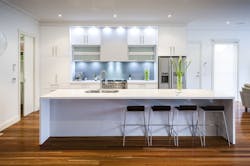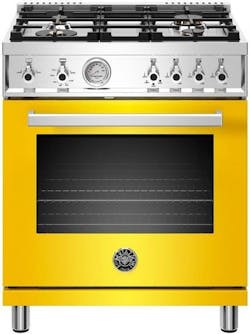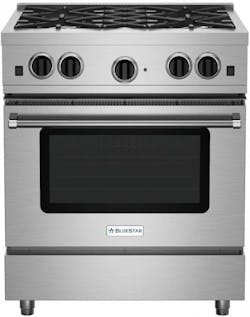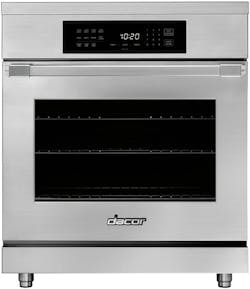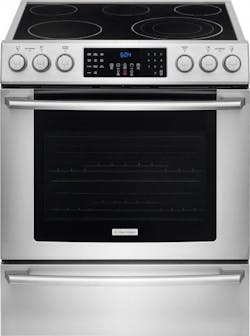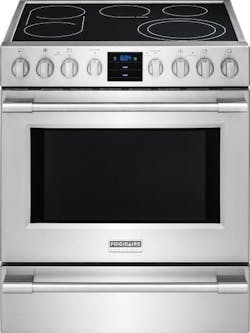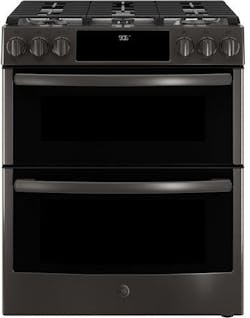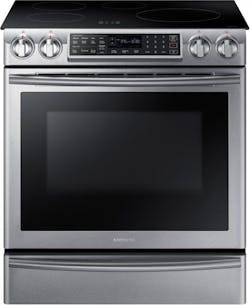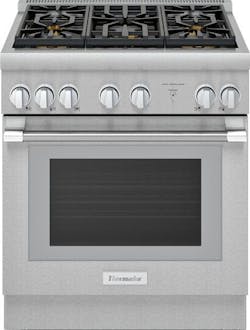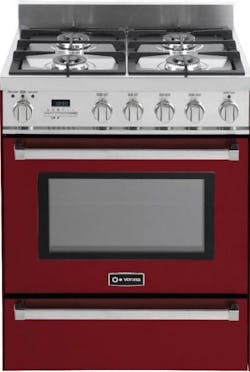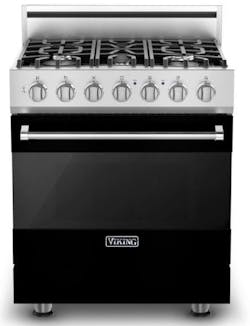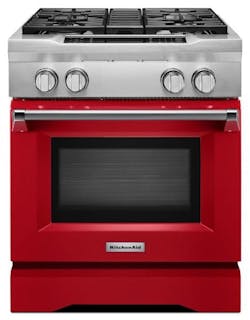30-Inch Range Buying Guide: Everything You Need to Know
The 30-inch range is the unwritten standard cooking appliance in almost all homes and remodels, but selecting the best unit for your clients is no easy task.
Should you go with gas or electric? Is induction all that it’s cracked up to be? Should you do freestanding or slide-in? There are many things to consider.
“The range is the workhorse of the kitchen, and if it's stylish, it's probably the centerpiece, too,” says Consumer Reports. “The choice between gas and electric ranges is largely dictated by what you have.”
This 30-inch Professional Series freestanding gas range offers four brass burners (including one 19,000-BTU high-output burner), and a soft close door. Shown here in Giallo Yellow, it also offers a true convection oven.
For many designers and their clients, the choice of fuel type is sometimes pretty simple. “If you don’t have a gas supply to your house, the answer is easy,” says the Houselogic blog at the National Association of Realtors. “But if you can go with either gas or electric, budget and cooking preferences play a significant role in deciding.”
A 30-inich electric is perhaps the most popular cooking appliance on the market, partly because electricity has been the most abundant fuel and electric stoves are the most affordable. Units with a smooth glass top are popular because they are easy to clean and provide a sleek modern look.
The Sealed Burner Series freestanding range offers four sealed burners, including one 21,000-BTU unit, extra-large convection oven, 1850-degree infrared broiler, and electronic ignition.
“Ranges with radiant electric smoothtops are the popular pick,” Consumer Reports says. Most, it says, have at least one high-power burner; most have expandable dual or triple elements that let you switch from a large, high-power element to a small, lower-power element within it; and some have a warming element in the center to keep side dishes warm. “There is a lot of residual heat, so when reducing the temperature it can take a few minutes to really settle at the lower setting,” Consumer Reports adds.
To make up for the lack of control, gas has been the popular choice with home cooks and chefs. And electric convection has been the gold standard for the oven.
This 800 DLX Series slide-in induction range features a True Convection oven, Meat Probe, Warming Drawer, AutoChef, PreciseSelect, and SafeStart technology.
“Listen to your inner chef,” Houselogic says. “Many cooks prefer gas ranges because the burner flame works as a visual temperature gauge and can heat things up quickly. Most bakers prefer electric ovens because of the consistent and even heat they generate.”
The dual-fuel range has made life easy for those consumers who want to cook with gas but bake with electricity. Combining a gas stovetop that chefs love with an electric-powered oven that provides even heat for baking, dual-fuel ranges are pricey but effective for the home chef.
Offering six induction burners, the Heritage 30-inch induction range boasts a 5.2-cubic-foot oven, LED Tilt-Vue panel, soft close door, and touchpad control.
“Because electric ovens tend to create more heat, resulting in more even and consistent results for baking, electric ovens are generally preferred to gas,” New Jersey-based Designer Appliances says on its blog. “If you were to set your temperature to 350 degrees in a gas oven, the flame will have to continuously turn off and on to maintain that heat. This is not only inefficient from an energy standpoint, but also results in temperature fluctuations and a less consistent cooking temperature. However, with an electric oven you can all but guarantee that your food will be baked at right around 350 degrees.”
But now there’s a new(ish) range that proponents say promises the control of gas with the efficiency of electric: Induction. The ranges with an induction cooktop use magnetic coils below the ceramic glass surface to send pulses directly to cookware, Consumer Reports explains.
The IQ-Touch Series is a 30-inch freestanding electric range with dual convection, warming drawer, five smoothtop burners, and a 4.6-cubic-foot oven.
Induction’s claim to fame is that it offers more precise temperature control. “You can even cook delicate items like dairy or chocolate for long periods, without worrying about fluctuations in temperature,” the Association of Home Appliance Manufacturers (AHAM) says. “It will take some practice, though, as induction cooking gets you to your desired temperature faster than gas or electric. Water, for example, will boil in about half the time. You’ll need to get used to the faster heating times.”
Once pricey, induction has come down in price (though users may have to buy new cookware that’s compatible with the technology). “Now, with more models hitting the market, it’s within reach for just about anyone interested in making the switch to induction,” AHAM says.
Offering a smooth-top glass top with radiant-heated elements, the Professional Series electric range offers a 5.1-cubic-foot oven,a SpacePro Bridge Element, convection oven, temperature probe, and a self-clean feature.
The percentage of electric surface cooking units and electric ranges that include induction is small, AHAM says, but it has risen steadily in recent years. According to AHAM factory shipment data, 15 percent of electric surface units included induction in 2016, up from 8 percent in 2010.
Once you and your clients have settled on fuel type, the next consideration is whether to choose a freestanding range or a slide-in unit. The freestanding range is the easiest to handle, says the Appliances Connection in Brooklyn, N.Y. It “gives you the option to install your range in between the cabinets, at the end of the cabinet against the wall, or freestanding on its own,” the supplier says. “ Freestanding ranges are the most popular purchase because they are more affordable than most slide-in styles. In addition to that, this type of range gives you the flexibility to place it anywhere in the kitchen without installation in the cabinetry because it has finished sides. The backsplash is another convenient feature, which provides protection for the wall behind the range from splashing liquids during cooking.”
The Profile slide-in gas range offers a WiFi connection capability, true European convection oven, Alexa and Google Home voice control, double oven, continuous grates, and Tri-ring burners. Available in black stainless steel, it has a 6.7-cubic-foot oven.
For those who desire a cleaner, built-in look, the slide-in range is the better option. They “are designed to fit flush with your countertop and seamlessly blend in with the surrounding cabinetry,” says Appliances Connection. “It requires installation between the cabinetry because unlike freestanding ranges, this style doesn't have finished sides.”
Because the slide-in range is wider top, it overlaps the countertop, preventing food, debris, and liquids from entering the space between the range and the countertop. Still, because of the advantages and the built-in look it creates, slide-in ranges typically cost more than standard freestanding units.
Offering 11 cooking modes, this five-burner electric range with ProBake convection oven features an EasyClean Mode, a 6.3-cubic-foot capacity, storage drawer, and glass touch controls.
These days stainless steel still rules the range category, but more designers are turning to color to strike a bold pose in the kitchen.
“For those of us who survived avocado green and harvest gold kitchens of 70’s, it’s no wonder neutral appliances have anchored kitchens for the past few decades,” Bryan Sebring, owner and president of Sebring Design Build in Naperville, Ill. “From bisque and white of the 80’s and 90’s to modern stainless steel, homeowners have been wary of new appliance colors for a long time.”
With a clean, built-in look, this slide-in induction range features a 5.8-cubic-foot dual-fan convection oven, Virtual Flame technology, WiFi connectivity, delay start, steam self-cleaning mode, warming drawer, and Sabbath mode.
But color is back and shifting back in that direction, says Sebring. Color in the most unexpected places can have a major impact. “Of course if a red pepper range isn’t your style, don’t worry,” says Sebring. “You don’t have to delve that deep into color for your kitchen to be on trend, but you do have more options than stainless steel to consider for your kitchen appliance colors.”
The Pro Harmony Professional Series range offers dual-fuel, five sealed star burners, ExtraLow simmer burners, a convection oven, Self-Clean mode, and one telescopic rack. It also offers continuous grates and Sabbath mode.
This dual-fuel freestanding range offers four burners, sealed cooktop, a 3.6-cubic-foot convection oven, a self-cleaning mode, warming drawer, and two 17,000-Btu burners.
The 3 Series freestanding range offers a gas cooktop and a true convection oven. Offering five sealed burners (including a 17,000- and 18,000-Btu units), it has a SureSpark ignition system and a self-clean cycle.
Available in on-trend colors (such as red and cobalt blue), this freestanding gas range offers a convection oven with 4.1 cubic feet of capacity, Sabbath mode, cast iron grates, and a variable self-cleaning system.
